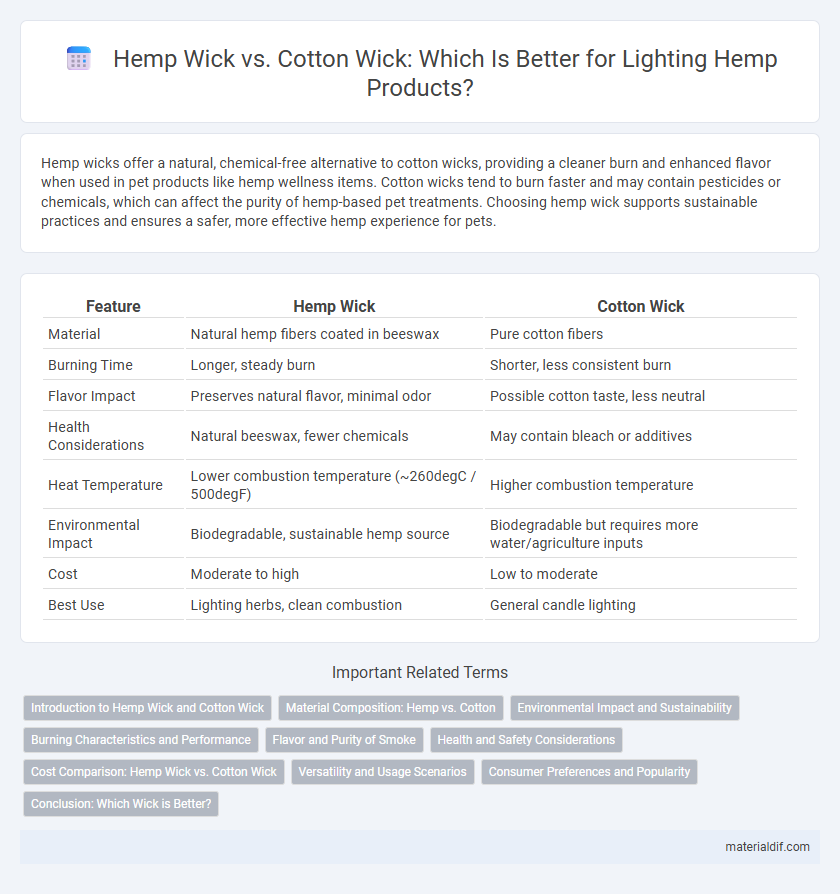Hemp wicks offer a natural, chemical-free alternative to cotton wicks, providing a cleaner burn and enhanced flavor when used in pet products like hemp wellness items. Cotton wicks tend to burn faster and may contain pesticides or chemicals, which can affect the purity of hemp-based pet treatments. Choosing hemp wick supports sustainable practices and ensures a safer, more effective hemp experience for pets.
Table of Comparison
| Feature | Hemp Wick | Cotton Wick |
|---|---|---|
| Material | Natural hemp fibers coated in beeswax | Pure cotton fibers |
| Burning Time | Longer, steady burn | Shorter, less consistent burn |
| Flavor Impact | Preserves natural flavor, minimal odor | Possible cotton taste, less neutral |
| Health Considerations | Natural beeswax, fewer chemicals | May contain bleach or additives |
| Heat Temperature | Lower combustion temperature (~260degC / 500degF) | Higher combustion temperature |
| Environmental Impact | Biodegradable, sustainable hemp source | Biodegradable but requires more water/agriculture inputs |
| Cost | Moderate to high | Low to moderate |
| Best Use | Lighting herbs, clean combustion | General candle lighting |
Introduction to Hemp Wick and Cotton Wick
Hemp wick is a natural fire-starting tool made from hemp fibers coated in beeswax, prized for its eco-friendly and chemical-free combustion. Cotton wick, commonly used in candles and lighters, is composed of twisted or braided cotton strands that burn evenly but may contain chemical treatments. Choosing between hemp wick and cotton wick depends on preferences for sustainability, burn quality, and usage in applications such as smoking or candle making.
Material Composition: Hemp vs. Cotton
Hemp wick is made from natural hemp fibers, offering durability and a slower, cleaner burn due to its low chemical treatment, whereas cotton wick consists of densely woven cotton fibers that ignite quickly but may produce more residue. The plant-based cellulose structure in hemp provides better heat resistance compared to the more absorbent and flammable cotton. Hemp's eco-friendly cultivation and biodegradability also make it a sustainable alternative to conventional cotton wicks.
Environmental Impact and Sustainability
Hemp wick demonstrates superior environmental sustainability compared to cotton wick due to hemp's rapid growth cycle, lower water usage, and reduced pesticide requirements. Its biodegradable nature and carbon sequestration ability further minimize ecological impact, whereas cotton cultivation often involves intensive resource consumption and chemical inputs. Choosing hemp wick supports eco-friendly practices by promoting renewable materials and decreasing agricultural strain.
Burning Characteristics and Performance
Hemp wick offers a cleaner burn with fewer toxins and less smoke compared to cotton wick, due to its natural resin content and slower combustion rate. Cotton wicks tend to burn faster and at higher temperatures, which can cause harsher inhalation experiences and increased char buildup. The superior heat resistance and even burning of hemp wick enhance flavor preservation and provide a smoother, more controlled ignition.
Flavor and Purity of Smoke
Hemp wick provides a cleaner and more natural flavor compared to cotton wick, as it burns at a lower temperature and without chemical additives, preserving the purity of the smoke. Cotton wick often contains bleaching agents and synthetic materials that can introduce unwanted tastes and impurities during combustion. Using hemp wick enhances the overall smoking experience by delivering a smoother, more genuine hemp flavor with minimal impact on smoke quality.
Health and Safety Considerations
Hemp wick offers a natural, chemical-free alternative to traditional cotton wicks, reducing the risk of inhaling harmful substances often present in bleached or treated cotton. Its slower, steadier burn generates less soot and fewer toxic byproducts, enhancing respiratory safety during use. Choosing hemp wick supports a cleaner combustion process, minimizing exposure to carcinogens compared to conventional cotton wicks.
Cost Comparison: Hemp Wick vs. Cotton Wick
Hemp wick generally costs more upfront compared to cotton wick due to its natural sourcing and durability, but it offers longer-lasting use which can reduce overall expenses. Cotton wick is cheaper initially but tends to burn out faster, leading to more frequent replacements and potentially higher long-term costs. When comparing costs, the sustainability and reuse potential of hemp wick often provide better value over time despite its higher initial price.
Versatility and Usage Scenarios
Hemp wick offers greater versatility than cotton wick due to its natural resin coating, making it ideal for lighting cigarettes, candles, and campfires with consistent burn quality. Cotton wicks are primarily designed for candle making, providing even flame distribution but lacking the multifaceted utility of hemp wick. Hemp wick's durability and slower burn time enhance its usage scenario in outdoor and herbal applications where controlled ignition is crucial.
Consumer Preferences and Popularity
Hemp wick has gained significant popularity among consumers for its natural, chemical-free properties and slower, cleaner burn compared to cotton wick. Many users prefer hemp wick due to its sustainability and durability, which enhance the smoking experience without imparting unwanted tastes. Cotton wick remains common but is often criticized for burning faster and sometimes containing residual chemicals, making hemp wick the favored choice among eco-conscious and health-aware consumers.
Conclusion: Which Wick is Better?
Hemp wick outperforms cotton wick due to its natural, chemical-free composition and slower, more controlled burn, enhancing flavor and reducing inhalation of harmful substances. Cotton wicks often contain chemicals from processing and burn faster, leading to harsher hits and potential health risks. For a safer, more flavorful experience, hemp wick is the superior choice for lighting smoking or vaping devices.
Hemp wick vs cotton wick Infographic

 materialdif.com
materialdif.com